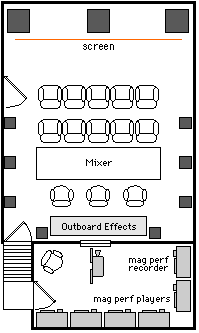| . |
 |
The many soundtracks as well as a positive copy of the conformed negative
are sent to a mixing stage. |
 |
| |
|
| |
Once again, my point here is not to explain the works of a mixing
facility, just to show how sync is maintained throughout the production in the film
industry. |
| |
You'll find a projector for the picture, several (sometimes more than ten !) audio
mag perf players and at least one mag perf recorder. Each player feeds different
inputs of the mixer, the master bus of the mixer feeds the input of the recorder.
All the tape machines and projector run in sync, controlled by the sound engineer
from a remote near the mixer. |
|
 |
The picture reel is set on the projector, with the "start cross" facing
the projector's shutter (part where the picture is read).
All the sound reels are set on the mag perf players, with the "start cross"
facing the playback head. Set silence or atmos loops for each scene are prepped :
the many spare tape guides found on mag perf machines serve this purpose, that way,
longer sized loops can sway back and forth between them.
A blank tape (which will become the master tape) is set on the mag
perf recorder. A "start cross" is drawn on the frame that happens
to be in front of the record head once the tape has been correctly threaded
from supply to take-up reel.
All of these elements will run in sync, whatever movement chosen by
the sound engineer on his remote.
Before he starts his mix (recording the mixer's output on the recorder's tape), the
sound engineer won't forget to drop the recorder in record mode just before
the 1kHz so as to copy the sum (hopefully a single "bleep")
of the 1000 Hz frames on the master tape.
Once the mix is done, a technicien will replace the beginning of the master tape
with leader tape, being extra careful (!!!) when he draws a new "start cross"
at the exact same position, and when he places a new frame of 1 kHz, at the exact
position it was recorded. |
|
|
![]()